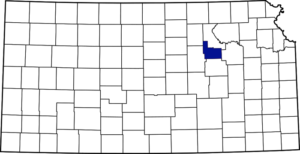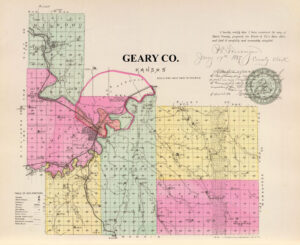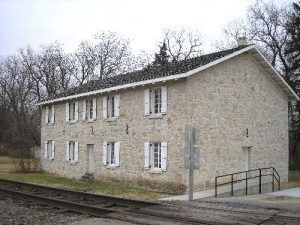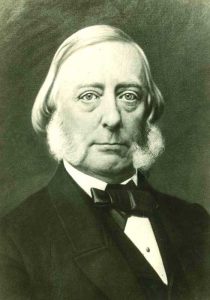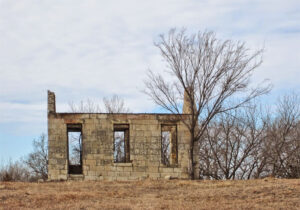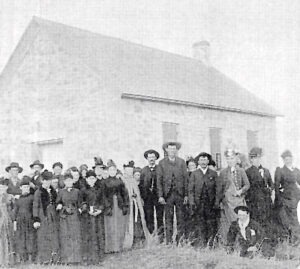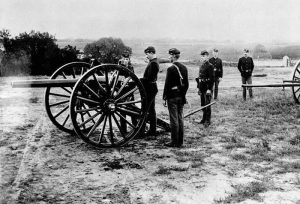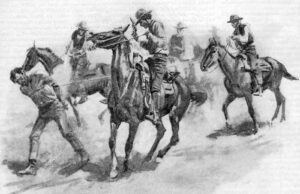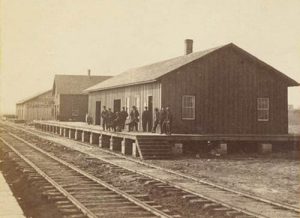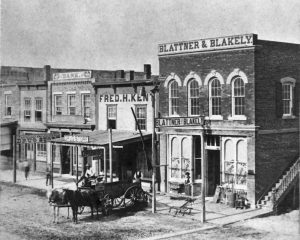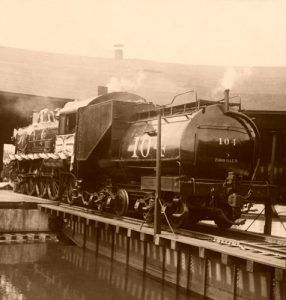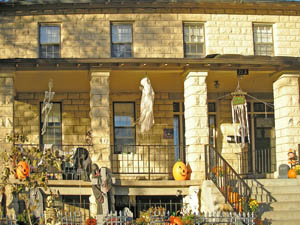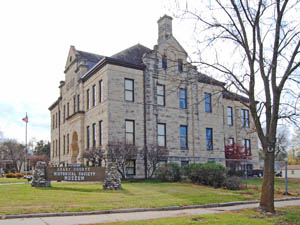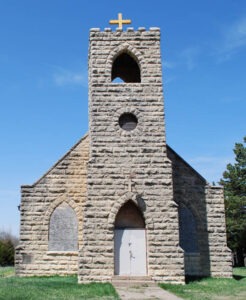
Smoky Hill River in Geary County, Kansas, by Kathy Alexander.
Towns & Places:
Grandview Plaza
Junction City – County Seat
Milford
Ogden
Pawnee, Kansas – First Territorial Capitol
Geary Lake Falls
Geary State Fishing Lake
Geary County, Kansas, located in the northeastern part of the state, was named in honor of John Geary, the first mayor of San Francisco, California, a governor of Kansas Territory, and the 16th governor of Pennsylvania. Its county seat and the most populous city is Junction City. As of the 2020 census, the county population was 36,739, the highest.
Originally called Davis County, it is in the third tier of counties south of Nebraska and the fifth West of the Missouri River. It is bounded on the north by Riley County, east by Riley and Wabaunsee, south by Morris and Dickinson, and west by Dickinson and Clay. It is irregular in shape, containing 404 square miles, of which 385 square miles is land and 20 square miles is water. It is the second-smallest county in Kansas by land area and the third-smallest by total area.
The east and central portions of the county are rough and hilly along the streams, but the southeastern and western parts are undulating prairie. The county was well watered by the Republican and Smoky Hill Rivers, which unite near Junction City to form the Kansas River. The county’s surface is almost entirely prairie, with only over three percent being timbered. The timber was confined exclusively to the margins of the rivers and creeks, the average width of the timber ranging from one-fourth to three-fourths of a mile. The timber consisted of several varieties, including white and burr oak, hackberry, black walnut, elm, cedar, sycamore, ash, hickory, and cottonwood.
Magnesian limestone, of the very best quality, was abundant, and several excellent quarries were opened. From these quarries, considerable stone was furnished for the new capital at Topeka. Coal was also found.
The first white men to visit Geary County were Spanish explorer Francisco Vasquez de Coronado and his associates in 1542, when they searched for the Land of Quivira and the Seven Cities of Gold.
French explorer Claude Charles du Tisné visited the area on an expedition to visit the Osage and the Wichita Indians in 1719. More French explorers came through the county in 1724 with Etienne Veniard de Bourgmont’s expedition along the south bank of the Kansas River. General John C. Fremont’s exploring expedition to the Rocky Mountains crossed the Smoky Hill River in Geary County in June 1843 and remained in the neighborhood for several days.
In 1852, Colonel T.T. Fauntleroy of the First Dragoons recommended the location and establishment of a fort at, or near, the mouth of the Republican River. In the fall of the same year, a detachment of dragoons arrived at the site of the fort, to which they gave the name of Camp Center. In the following spring, Fort Riley was established, having been named after a distinguished general in the United States Army. At that time, it was supposed that the Kansas and Smoky Hill Rivers were navigable, and a steamer named Excel had made several trips as far west as the Smoky Hill River, but this idea was soon abandoned.
In 1853, settlers began to come into the territory now embraced within the bounds of Geary County.
When Kansas was organized as a territory in 1854, only 20 regional voters were represented within the county. One of the first to locate permanently was Thomas Reynolds, who settled near Ogden in June 1854.
The Pawnee Town Association was organized on November 26, 1854. Colonel V. P. Montgomery was president of the association, and William Hammond was secretary. Many of the officers stationed at Fort Riley took an active part in managing local affairs. The first election, in what is now Geary County, was for the election of a delegate to Congress. It was held in November 1854, and the voting place was at the house of Thomas Reynolds. The Free State candidate was R. P. Flenniken, and the pro-slavery candidate was J.W. Whitfield. The election judges were all officers of the army, and of the 40 votes cast, Flenniken received 31 and Whitfield 9.
In December 1854, the town of Pawnee was started on the north shore of the river near Fort Riley. A levee needed to be built if this was to be the head of navigation, beyond which boats could not go, and where steamers would load and unload. With commendable energy, the town association went to work and expended much time and money on its construction. The pioneer merchant of Geary County was John T. Price, who opened a grocery store in Pawnee that year.
Some trouble arose in its establishment, as a few settlers had already settled on the land. It is said that Colonel Montgomery, the president of the town company, had the settlers driven off by a squad of soldiers in January 1855. Governor Andrew Reeder, the territory’s first governor, assured the association that if the necessary buildings were completed in time, he would convene the first territorial legislature at Pawnee.
In March 1855, a second town company was formed, of which William Hammond was president, and a town was laid out and called Chetolah. Located near the mouth of Lyon Creek, Abram Barry and G. F. Gordon made a survey, but no house was built upon the site.
Before the close of March 1855, a third town company was organized, which laid out the town of Ashland on McDowell’s Creek and made a settlement.
That year, according to the promise made by Governor Andrew Reeder, the executive office was removed to Pawnee. On March 31, 1855, the first election for members of the territorial legislature was held, and Pawnee was the only voting precinct in what is now Geary County. It formed a part of the eighth representative district and the sixth council district. M.F. Conway was the Free-State, and John Donaldson was the pro-slavery candidate for the council; S.D. Houston was the Free State, and Russell Garrett was the pro-slavery candidate for the House of Representatives. The Free-State candidates were elected by a vote of 53 to 23.
In April, another town company, composed of A, was organized. Barry, S.D. Houston, B.E. Fullington, Moses Younkins, and Frank Smith founded the town of Bacheller (which later changed to Milford) on the east bank of the Republican River and about four miles south of the north line of Milford Township.
In July, the first territorial legislature convened there but soon after adjourned to the Shawnee Mission in Johnson County. The governor vetoed the resolution to adjourn, but the territorial court sustained the measure, and Pawnee lost the capital. This was a hard blow to the town company.
The town of Island City was established in July 1855, and Riley City was established in September, a mile or two away. Both these towns were located on the south side of the river.
Davis County was one of the 33 counties created by an act of the first territorial legislature on August 30, 1855. It was named in honor of Jefferson Davis, who was Secretary of War at that time.
In September 1855, the soldiers from Fort Riley destroyed the town of Pawnee, it having, by a change of the boundary lines, been brought within the limits of the military reservation.
On December 20, 1855, the Pawnee post office was moved to Fort Riley that year, with Robert Wilson as postmaster.
In the legislature that convened at Topeka in March 1856, Davis County was represented in the upper branch by J.H. Pillsbury and in the lower branch by Abram Barry.
In June 1856, a party of Cincinnati, Ohio speculators organized themselves into a company known as the “Cincinnati and Kansas Manufacturing Company,” located in the town of Millard. J. McArthur, of Cincinnati, was president of the company, and D. Wilson, of Millard, was an agent of the company. Millard was laid out on the identical land on which Junction City now stands, but it was soon abandoned; not, however, until the schemers who had embarked on the plan of establishing a bogus town had realized thousands of dollars from the sale of lots, to which they had, and could give, no title. The nearest Millard came to being a town was the building of one house, which was afterward attached and sold.
That month, the government built a bridge across the Republican River, a little way above the forks, but the winter that followed saw it washed away by high water. The first wheat raised in the county was on a patch of ground containing two acres on Humboldt Creek in the summer of that year. It was raised by a man named Spencer and was sold to G.K. Harris, who hauled it to Topeka, a distance of 75 miles, to be ground.
Governor John Geary visited the county in October 1856. He had, as an escort, a company of dragoons under the command of Major Sibley. Coming from the South, he crossed the river at Riley City by ferry to Pawnee. Riley City at that time contained eight houses and Pawnee two.
An act to complete the organization of Geary County as a separate corporation was passed on February 20, 1857. The legislature elected two county commissioners, a probate judge, ex-officio chairman of the board, and a sheriff. These officers were to hold office until the first Monday in October, when a county election was ordered for county officers and to decide the permanent location of the county seat. The first commissioners were Robert Reynolds, C.L. Sandford, and N. B. White, and the first meeting was held on March 16, 1857, but only Reynolds and Sandford were present. G.F. Gordon acted as clerk, but E.L. Pattie was later regularly appointed to that position. H.N. Williams was elected sheriff; P.M. Barclay, treasurer; and G.F. Gordon, justice of the peace.
In the summer of 1857, another town company was organized by Thomas Reynolds, A.J. Mead, J.R. McClure, Robert Wilson, and Abram Barry. This company selected a site to which they gave the name of Humboldt. The organizers’ objective was to locate their town on the abandoned townsite of Millard, but their enterprise proved an utter failure. In September 1857, another town company was organized under the name of the “Kansas Falls Town Company.” This company located a townsite on the Smoky Hill River, about seven miles southwest of Junction City and almost on the western boundary line of the county. In that year, Pawnee disappeared as a voting precinct.
At the election of October 5, 1857, for legislature members, the voting precincts were Ashland, Ogden, Chetolah, Clark’s Creek, Riley City, and Montague’s. At the election, 126 Free-State and 30 Democratic votes were cast.
In the fall of 1857, the Junction City Town Company was incorporated, with J. R. McClure as president, Daniel Mitchell as secretary, and Robert Wilson as treasurer. The town site survey began at the latter end of December and finished in the summer of 1858.
At the same time, a U.S. land office had been established at Ogden, and the contest over the townsite was heard here. The hearing of the case continued for six weeks, after which it was submitted to the authorities at Washington for the final decision, which resulted in favor of the Junction City Company.
In April 1858, another town company was organized, and a town named Cedar Point was located on Clark’s Creek. A.J. Baker was president of this company, and E. Davis was secretary.
Work on the first building in Junction City commenced in May 1858, and it was erected near the intersection of Washington and Seventh Streets. The first sermon preached in the town was by Reverend W. Millice of the Methodist Episcopal Church, South, who held service in July in a frame building on the northeast corner of Seventh and Washington Streets. In the same month, Union Lodge A. F. & A. M. was established in the town, and the first meetings were held in a roughly constructed log cabin.
The first newspaper was the Sentinel, edited by B. H. Keyser. It appeared in June 1858 as the organ of the Democratic Party. In 1859, Samuel Medary bought this paper, and the name changed to Kansas Statesman.
The legislature of 1859 located the county seat at Ashland, on McDowell’s Creek.
In June 1859, Junction City was visited by Horace Greeley, who delivered a lecture to the citizens.
In the summer of 1859, a contest arose between the Junction City Town Company and the Millard Company over the land embraced in the townsite. Each claimed it by its organization and location.
In the spring of 1860, Junction City was made a voting precinct, and a petition was presented to the commissioners to change the county seat. Accordingly, the question was submitted to the people, and an election was ordered for June 25, 1860. Ashland, Junction City, Riley City, and Union were the contestants. The election resulted in 287 votes for Junction City, 129 for Union, 3 for Ashland, and 3 for Riley City, and thus Junction City became the permanent seat of justice. The first meeting of the county board was held there on July 2, 1860.
Before 1861, there was no contract for carrying mail farther west than Junction City, but in April of that year, Samuel Orr was contracted to carry mail once a week from Junction City to Salina, a distance of about 45 miles.
The Frontier Guide was the second newspaper, started in 1861 in Junction City.
Upon the outbreak of the Civil War, Geary County was full of excitement. However, the people were not all of one mind about the war’s righteousness. While the sentiment was essentially in favor of the Union, a few favored secession, some of whom immediately went South and joined the Confederate Army. At that time, the county’s population was 1,163.
The first mail that started from Junction City to Fort Larned, a distance of about 150 miles, was on June 20, 1861, the carriers being S. Orr and P. E. Weston. The facts connected with the county’s history in 1861 relate chiefly to army matters. There was enlisting, mustering, meetings, speeches, uniforming, arming, equipping, fifing, drumming, cheering, and departing, and a regular hurrahing for the Union all year round. On December 12, 1861, a daily mail commenced to run between Junction City and Leavenworth.
On March 10, 1862, some of the soldiers stationed at Fort Riley, dissatisfied with the sentiments of secession expressed in the columns of the Kansas Frontier, attacked the newspaper office and did much damage.
A meeting of the citizens denounced the soldiers’ action, and it is not sure whether this meeting or something published in the Frontier stirred the soldiers to a higher indignation. Some of the citizens, not liking this manner of dealing with a private citizen’s property, held a meeting the following day in Taylor’s Hall and denounced the soldiers’ actions. The meeting was not of the most orderly kind, and quite a boisterous time was had over a resolution introduced to the effect that the paper was loyal and asking the meeting to endorse it as such. It is unknown whether the proceedings at this meeting or something said by the editor of the Frontier further aroused the soldiers’ anger. The same week, they again attacked the newspaper office, which was demolished this time. In the attack, they wounded a man named C.A. Wood, from the effects of which he shortly afterward died. Several regiments were encamped at Fort Riley, and the outbreaks of the soldiers became so frequent and annoying that the town was placed in charge of Captain Sylvester of the Twelfth Wisconsin, who acted as provost guard. Captain Sylvester had the reputation of having been very rough on saloons, and whether by his orders or the orders of someone else, 13 barrels of whisky were broken open and spilled on May 6, 1862, at a place named Island City on the opposite bank of the river from where Pawnee once stood. This place took its name from the fact that it was located on a piece of land, which, in some seasons, would be surrounded by water owing to a slough or strip of low, wet land by which it was encompassed. At the extreme western point of this island, some parties had once undertaken to build a town to which they gave the name of West Point, but the town never existed outside the imagination of its would-be founders. The place’s name was afterward changed to Whisky Point, which derived this name from somebody in court having said he would rather die in Junction City than live at Whisky Point, referring by this remark to West Point. On May 14, 1862, a very unpleasant affair occurred at Whisky Point between a party of soldiers, in which two were killed and one wounded. On the same day, the provost marshal, with a squad of men, went around and closed up every saloon in which intoxicating liquors were sold.
In May 1862, considerable excitement was created in Geary and the adjoining counties by a party of Comanche Indians, who entered the Republican Valley, committed depredations, and drove out the settlers. The people within easy reach of Fort Riley had little to fear because of the troops stationed there, and many settlers from further west sought refuge in Junction City. However, among those farther west, great consternation prevailed, and Junction City was sought by many as a place of safety.
The first stagecoach that left Junction City for the far West on August 4, 1862, was considered quite an event. It was the formal opening of the Smoky Hill route to Santa Fe, New Mexico. Before that time, all travel had been over the Santa Fe Trail, which passed through Morris County to the South of Davis County. Five days later, the first stage from the West arrived in town.
On September 17, 1862, the whole frontier was thrown into a state of feverish excitement by a band of bushwhackers, who made a dash through the country and raided Salina. Although the people of Davis County were comparatively safe from such incursions, there was no telling what might happen in those unsettled times of trouble and danger. To guard against surprises, guards were posted every night around Junction City so that a timely warning might be given to the inhabitants upon the first appearance of the approach of an enemy. This system of night guarding was kept up for several weeks, but it was discontinued.
On March 23, 1863, the people of Junction City had a visitor who filled them with much alarm and caused them to move as lively as if they had been invaded by both Comanche and bushwhackers combined. They might shoot off Indians and guerrillas, but what they had to contend against now was not to be frightened away with bullets. On that day, the whole town was startled by the cry that a terrible prairie fire was approaching, which threatened the town. Immediately, everybody was on the alert, men, women, and boys, to fight the fire, some with mops, some with brooms, and some with whatever they could get to beat out the flames. The fire swept over the uninhabited portion of the town site, but the town itself received little if any injury.
The winter of 1863-1864 was quite a severe one, and a significant amount of snow fell; in some places, the ground was covered to 18 inches, rendering travel extremely difficult and very often stopping it altogether. Travel was so retarded that settlers on Clark’s Creek received no mail for six successive weeks.
The first draft for the army was ordered on March 10, 1864, of which Davis County was required to furnish 14 men.
In September 1864, Confederate General Sterling Price made a raid through Kansas. To give him a warm reception when he struck Davis County, business was suspended entirely, and great activity prevailed among army men. The Fifteenth Regiment, chiefly recruited in Davis and adjoining counties, was encamped on the Republican River near where the present bridges cross that river, and all the militia were in camp. Price did not come, however, and business resumed its ordinary channels after a three-week suspension.
A desire had long existed among the people to change the county’s name from Davis to one more agreeable to the Union sentiment of the county. They did not like the idea of their county being named after Jeff Davis, then President of the Confederacy and commander-in-chief of the Rebel army. Two years before, an effort had been made to have the name changed from Davis to Lyon in honor of Brigadier General Nathaniel Lyon, who was killed in the Battle of Wilson’s Creek, Missouri, during the Civil War and who had taken quite a part in the early settlement of the county. Failing in this, they made another effort in 1864 to have it changed to Lincoln, but in this also, they failed, so it is that Davis County retained the name of the individual who was placed at the head of the rebellion for the destruction of the Union.
In May 1865, D A. Butterfield organized the Butterfield Overland Despatch Company and proposed to open up the Smoky Hill route to Denver, Colorado. On June 25, the company’s construction train arrived at Junction City, from which point they started west on July 3 and arrived in Denver on August 7. In September, the coaches of the company began making tri-weekly trips from Junction City to Denver, and in the following month, one of the coaches was attacked by Indians near Cow Creek and burned.
In September, quite an excitement was created over the arrest of two strangers charged with horse stealing. Sheriff Purinton had them in his charge at the Eagle Hotel in Junction. The place was soon surrounded by a mob, some of whom entered the hotel and took the prisoners away from the sheriff. After which, they carried them to the sawmill on the Smoky Hill River, where the two men, guilty or innocent, were hanged.
Before 1866, the county offices were on the upper floor of a stone building at the corner of Sixth and Washington Streets at Junction City. This building was destroyed by fire on April 8, and a few days later, the town and county were swept by a tornado that did significant damage.
In January 1866, although Junction City was the county seat, it was without a county building, and several county officers held their various offices in the upper story of a two-story stone building that stood at the corner of Sixth and Washington Streets. On the night of April 8, this building was destroyed by fire, and two or three days afterward, a fearful tornado swept over the county, doing a great deal of damage to property both in the town and country.
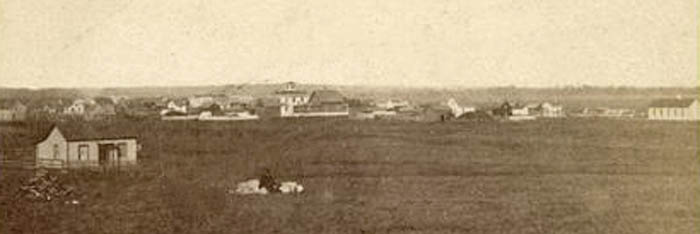
Junction City, Kansas by Alexander Gardner, 1867.
The first stagecoach from Santa Fe, New Mexico, arrived on the Smoky Hill Trail in Junction City on June 29, 1866. The first train through mail for Santa Fe, over the Smoky Hill route, left Junction City on July 2, 1866. It was a tri-weekly trip that took 14 days.
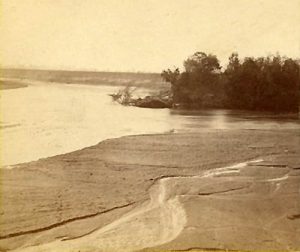
The junction of the Smoky Hill and Republican Rivers near Junction City, Kansas, by Alexander Gardner, 1867.
On July 5, 1866, the county commissioners, having decided that a bridge across the Smoky Hill River in the vicinity of Fogarty’s Mill was necessary, authorized the sale of bonds for building the bridge to $20,000.
In 1867, bonds were voted by the people to aid in the construction of the south branch of the Union Pacific Railroad and the Kansas Pacific Railroad, which was the first railroad to enter Geary County, being completed as far as Junction City on November 10, 1866. Bitter contests over the building of bridges across the Republican and Smoky Hill Rivers, and the large influx of immigration. Completing the Kansas Pacific railway through Davis County and establishing a tri-weekly line of mail coaches between Junction City and Santa Fe made 1867 a prosperous year for the county. Railway and other magnates from New York, Boston, Philadelphia, and St. Louis visited Junction City in the year. A great tide of immigration flowed into the county with the opening of the railroads, and most of the desirable land was soon taken up.
In about 1868, the farming community was incredibly excited over introducing Texas cattle into the county, and several meetings were held in different locations to organize resistance to their entering. A strip of land about a mile wide, between the Smoky Hill and Republican Rivers, at their point of junction with the Kansas River, which was formerly part of the Military Reservation land, became an object of dispute between the Union Pacific Railroad Company and the Republican River Bridge Company. Both companies claimed the land, and the railway company had included it in their addition to Junction City. The River Bridge Company brought suit to enjoin the railway company from selling lots in this addition, which was eventually decided against the Bridge Company.
For a long time, the county had been infested by a gang of horse thieves, to the great annoyance of the settlers. A week passed, but a settler somewhere in the county would have one or more horses stolen. Tonight, the thieves would operate on Humboldt Creek, and tomorrow night, they would operate on Lyon’s Creek, so that they would change their field of operations at each theft. It began to be suspected that transient thieves did not carry on such a systematic method of horse stealing, and suspicion settled firmly down upon a party located at intervals over the county. Among the suspected party was Thomas Reynolds, who, on the morning of August 22, 1868, was found hanging from a tree, lifeless. It never became satisfactorily known who did the hanging, but the supposition was that it was done by the balance of the gang, who entertained great fears that Reynolds would betray them. A coroner’s jury labored for three months to ascertain how Reynolds came to his death and finally concluded that he met his death at the hands of unknown persons.
To avoid any further trouble caused by black and white children attending the same school in Junction City, a separate school was opened for colored children on September 30, 1868.
In the early part of December 1868, quite a heavy snow fell, significantly impeding travel. The snow drifted so fearfully that there was no communication either east or West of the city for a week. This month, the Union Pacific Southern Branch began to assume tangible shape, and the contractors advertised for ties. Twelve miles of the road were located south of town.
In 1870, Geary County was sued by the Missouri, Kansas & Texas Railway Company for $165,000 in bonds that the county had voted to aid in the construction of the railroad but which had never been paid. After being in the courts for some time, the case passed to the Supreme Court, where a decision was rendered in favor of the county.
In August 1870, a man named Sanderson, who lived a little way from Junction City, was suspected of being connected with a gang of horse thieves and having committed several other offenses; he was arrested and placed in custody. According to the law, his preliminary examination should have occurred in Junction City. Instead, he was handcuffed and taken in a horse-drawn vehicle to Jackson Township for the ostensible purpose of having an examination. He went under the sheriff’s charge and a guard of six men. Arriving at the place of examination, no Justice of the Peace could be found, and it would be several hours before he could appear. In the meantime, news soon spread far and wide that Sanderson was there, and in a short time, a mob gathered and demanded his surrender by the sheriff. The sheriff deserted his prisoner and told him to defend himself as best he could.
How could the unfortunate man defend himself against a howling mob with a pair of handcuffs on his wrists and without a weapon in his hands? He ran and got into the horse-drawn vehicle, several shots being fired at him as he entered. When Sanderson entered, a portly gentleman was sitting in it named John Gross, who had gone over as one of the guards. Mr. Gross was not used to having lumps of lead flying through the air. When he heard the bullets, the 225-pound man managed to scramble through a window in a hurry. In the meantime, Sanderson jumped from the vehicle, running for the trees, but two or three men pursued him on horseback and shot him as he was running, killing him while he was manacled. They then turned their attention to two brothers of Sanderson who had accompanied him from Junction City. To these, they gave ten minutes to prepare their wills, but for some cause or other, they changed their minds and gave them so many hours to leave the county. They both left. One never returned, but the other did and became a respected neighbor and an honest farmer.
July was a month of railroad excitement, and three propositions were submitted to the people. One was for $150,000 to the Kansas & Nebraska Company; another was for $100,000 to the Junction City & Fort Kearney, and the third was for $100,000 to the Holden Branch or the Lawrence, Topeka & Junction City Railway. Men went out all over the county canvassing in favor of the bonds, while others filled columns of the Union on the same subject. The election on the bonds was held on September 3, 1871, and every one of the propositions was carried by the majority.
The following year, there was no decrease in the railroad fever. In February, the county commissioners submitted a proposition for an additional $100,000 for the Junction City & Fort Kearney Railway, which was voted on April 2 and carried by a 357 majority.
The last half of 1871 and the first six months of 1872 witnessed a large influx of people to the county. In 12 months, more than 150 new farms were opened.
The First National Bank was established in Junction City in May 1872, with Robert McBratney as president and James Streator as cashier.
Geary County constituted one municipal township until August 7, 1872, when the board of commissioners divided it into two civil townships, Smoky Hill and Jackson. In time, these were subdivided to form eight townships into which the county is now divided — Blakely, Jackson, Jefferson, Liberty, Lyon, Milford, Smoky Hill, and Wingfield. In 1873, the legislature changed Geary County’s boundaries by removing Ashland Township and adding it to Riley County. At the same time, Milford Township was taken from Riley and annexed to Geary.
The legislature of 1873 changed the boundary lines of Davis County, taking Ashland Township from Davis and adding it to Riley County. Milford Township was taken from Riley County and annexed to Davis County.
The county jail was completed and ready for occupancy in September 1873.
In November 1873, a destructive prairie fire swept over the country near Humboldt Creek, doing immense damage and entailing heavy losses to the settlers.
In December 1874, Mr. Fogarty completed his dam across the Smoky Hill River. This was the year of the great grasshopper raid, by which Davis County was ravaged entirely like every other county in the State. Crops were utterly destroyed, and a great many of her people were thrown into a state of poverty. A few, becoming discouraged, left the State, but the majority remained. While many suffered from the want of actual necessities, they met their adversity bravely and, in a year or two, were again on the road to prosperity. As everything was destroyed, the people had to be aided by outside sources, and early in 1875, the County Commissioners and the Ladies’ Aid Society began distributing aid to relieve the distressed. The number of people in the county rendered destitute by the grasshopper raid was 1,154.
In the summer of 1881, the northern portion of the county near Fort Riley was hit by a tornado that did considerable damage, but chiefly to the barracks and stables at the Fort. The barracks were, in a significant part, unroofed, and falling stones and timber killed several men. One stable was blown down in which there were thirty horses, and, however strange it may seem, only one of the number was killed. Some of the others were pretty severely bruised, and they were all so tightly wedged in between stones, timber, and debris that they had to be dug out.
By an act of the Kansas legislature on February 28, 1889, the county’s name was changed to Geary in honor of John White Geary, the third territorial governor of Kansas.
An act of March 11, 1893, attempted to change the county name back to Davis, provided a majority of the county’s people favored the proposition. However, the majority was against the change, and the name Geary remained.
In 1910, transportation was provided by the Union Pacific Railroad, which ran across the northwest part of the country, from northeast to southwest, with a branch northwest of Junction City. A branch of the Missouri, Kansas & Texas entered the South and terminated at Junction City, giving the county nearly 50 miles of main track railroad. The county population was 12,631, a gain of 1,937 during the preceding ten years. The assessed property valuation was 16,642,510, and the value of agricultural products for the year was $1,888,967.
In the following years, the population of the county gradually increased.
The county offers visitors recreation at Milford Lake and State Park and several sites that provide more information about its history.
Geary County properties in the National Register of Historic Places include the First Territorial Capital State Historic Site of Pawnee and Fort Riley’s Main Post Area.
Fort Riley Reservation – Exit 301, U.S. Highway 70, is Fort Riley’s main gate and the location of the Visitor Control Center. Entry requires a background check and a government-issued photo ID to receive a temporary Fort Riley Access Pass. Cell phone usage is not permitted while driving a vehicle on Fort Riley.
First Territorial Capital State Historic Site of Pawnee – This building was erected in 1855 in the now-extinct town of Pawnee for the first legislature of the territory of Kansas. The members were mainly Missourians fraudulently elected to make Kansas a slave state. They came in wagons and on horseback, well-armed, and camped out on the prairie. The session lasted from July 2 to July 6. The Missourians were determined to legislate nearer home and passed a bill to move to Shawnee Methodist Mission in present-day Fairway, Kansas. Governor Andrew Reeder vetoed the bill; it was passed over his veto, ending the session. All other acts, including the so-called Bogus Laws, were passed at the Shawnee Mission. The old Capitol building was partially ruined until its restoration in 1928 by the Union Pacific Railroad. It stands south of Huebner Road.
Custer House – Also called Quarters 24, this home, surrounded by a white picket fence, was constructed in 1855 of native limestone for $3,500. The Custer House reflects Fort Riley’s earliest history and authentically depicts military home life on the western frontier during the Indian Wars Period. The quarters are furnished to reflect the lifestyle of the late 1870s and early 1880s. It is one of two surviving sets of quarters from Fort Riley’s establishment, displaying the living conditions of a typical military family. Lieutenant Colonel George Custer is believed to have occupied the sister set of quarters (#21) while stationed here in 1866. Contrary to some stories about Custer, he did not leave Fort Riley and go to the Little Bighorn. It is now part of the U.S. Cavalry Museum and is open daily from Memorial Day to Labor Day and on weekends during early May and September.
Great War Memorial honors the soldiers who trained at Camp Funston for World War I. The monument was erected within a month following Armistice Day in November 1918. Major General Leonard Wood ordered the monument to be built in memory of the soldiers who trained at this camp. The monument’s inscription reads, “To the men who trained at Camp Funston for the Great War 1917-1919.” The 89th Division was organized here in August 1917 and was shipped overseas in May 1918. More than 7,000 of the division’s men were killed or wounded. The 10th Infantry Division was also formed here, but was still in training when the war ended. This division was demobilized in February 1919 without ever seeing combat. It is located on Huebner Road.
The U.S. Cavalry Museum and 1st Infantry Division Museum – These museums document the storied history of the American Cavalry and the “Big Red One.” Appropriately, the museums stand beside each other in the heart of Fort Riley’s historic Main Post. The Cavalry Museum’s south wing was built in 1855 and originally was the post hospital. The flat limestone identifies it as one of the four surviving buildings from the post’s initial construction. The building was renovated, and a clock tower was added in 1890 when it became the Cavalry School Administration Building. In September 1957, the building became the home of the Fort Riley Historical Museum. Five years later, it was renamed the U.S. Cavalry Museum, and today, it tells the history of the mounted branch of service from the Revolutionary War to 1950. The building directly to the rear of the Cavalry Museum is the 1st Infantry Division Museum. This building was constructed in 1905 for use as a barracks. In later years, it was used as offices for the Cavalry Board, which tested and reported on new equipment. During the 1960s and 1970s, it was used as the post library before being opened in June 1992 as the 1st Infantry Division Museum. Today, visitors may view exhibits that relate to the rich and colorful history of the Big Red One from 1917 to the present. Admission is free, but donations are accepted. They are located in Buildings 205 and 207 on Henry Avenue.
St. Mary’s and Main Post Chapels – The larger structure is the Main Post Chapel, constructed in 1897-98. This building was erected to serve the religious needs of the soldiers assigned to Fort Riley as part of the Cavalry and Light Artillery School. Chaplain Thomas Barry secured donations and funding to complete this chapel, formally dedicated on July 4, 1897. The smaller chapel behind the Main Post Chapel, known as St. Mary’s Chapel, was completed in 1861. This is the first stone chapel erected in Kansas. Lieutenant James Ewell Brown “Jeb” Stuart probably helped raise money to construct this church. St. Mary’s saw use as a depot during the Civil War and later as a school. The chapel was reconsecrated in 1938 as a Catholic Chapel. The two chapels are on Barry Avenue.
Post Cemetery – The Fort Riley Cemetery is the final resting place for soldiers, veterans, service family members, and two mass graves of those who perished in the cholera epidemics of 1855 and 1867. The cemetery covers 8.3 acres, with the first recorded burial in August 1854. Among the early burials were approximately 75 men, women, and children who died in the 1855 cholera epidemic. Other interments include three Medal of Honor recipients and other service members from all of America’s major conflicts since the Civil War. There are graves of Confederate soldiers captured during the Battle of Glorietta Pass, New Mexico, in 1862, who were brought to Fort Riley during the summer of that year. These soldiers were from the 2nd, 4th, 5th, and 7th Texas Mounted Volunteers. In addition, victims of a second cholera epidemic, which occurred in the summer of 1867, as well as victims of the 1918 influenza outbreak, rest in this quiet setting. German and Italian prisoners of war who died here during World War II are also buried here. The cemetery is located on Huebner Road.
Trolley Depot – The small building at the Sheridan and Pleasanton Avenue intersection was a trolley depot in the early 1900s. It was one of several stations between Fort Riley and Junction City and served as a waiting station and baggage room. The Army built the station in 1901, and the first streetcar ran in August. In 1908, the trolley line was moved farther north and extended toward Ogden. The spur leading to this station was abandoned, and the track was pulled up. The trolley line was extended to Manhattan in 1914 and continued until February 1934. The station was later used as a warehouse and workshop.
Geary County Historical Museum – Including a library and archives, the museum houses an extensive collection of vintage photographs, including the works of J.J. Pennell, newspapers dating from the Civil War, and Geary County’s genealogical records. The large limestone building displays three floors of exhibits of local artifacts and photographs that tell the story of Geary County. Visitors can step back in time and experience a Main Street based on shops from the Junction City historic downtown, see a tack room, parlor, and kitchen, see and hear the artistry of local American Indian tribes and those across the plains, practice Morse Code by trying the telegraph at an authentic Union Pacific Depot, and more. The auditorium is different every time, featuring rotating exhibits with the seasons. Admission is free. It is located at 530 N. Adams in Junction City.
Starcke House—Located at 5th and Adams, immediately south of the Geary County Historical Museum, this one-story brick house was once the home of a prominent Junction City merchant family.
Spring Valley Heritage Site – The Spring Valley Heritage Site features several historic buildings. These include the restored 19th-century one-room Spring Valley schoolhouse, which held classes until 1958 and was the last one-room schoolhouse in Geary County without plumbing. The working 1930s-era water pump and pony barn are still on the grounds. Frederich Wilhelm Lange was the first missionary sent to Kansas by the Lutheran Church – Missouri Synod in 1861. He made his home with the C.F. Wetzel family and preached his first sermon in Kansas in the Wetzel Log Cabin. Placed on the State and National Registers of Historic Places, it is cared for by the Geary County Historical Society and was moved to its current location in 2003. It is located west of Junction City at the intersection of K-18 and Spring Valley Road at 530 N Adams Street.
Buffalo Soldier Memorial – A tribute to the Buffalo Soldiers of the 9th & 10th Cavalry Regiments who served at Fort Riley. This stunning memorial, constructed of native limestone, serves as a backdrop for a nine-foot bronze sculpted statue of a Buffalo Soldier on his horse. The site of the memorial is near a one-of-a-kind 1940s government housing area once designated for the Buffalo Soldiers and their families during segregation. These brick single-family dwellings are the only remaining set in existence today. Nine informational plaques provide the history of the Buffalo Soldiers. It is located at Buffalo Soldier Park on 18th Street and Buffalo Soldier Drive in Junction City.
Civil War Memorial Arch—This monument symbolizes Geary County’s continuous connection to Fort Riley and the U.S. Armed Forces. Dedicated on September 8, 1898, this arch stands guard over the northeast entrance to Heritage Park. Erected as a memorial to those who gave their lives in the Civil War, the monument was planned and erected by the Grand Army veterans. The Arch is at the intersection of Washington Street (U.S. 40) and West 6th Street in Junction City, Kansas.
Vietnam Veterans Memorial—This 13-by-46-foot black granite memorial was erected and dedicated on July 4, 1987, in memory of all Kansans who died or were listed as missing in action while serving in the Army, Navy, Air Force, and Marine Corps during the Vietnam War. The memorial is in Heritage Park, at Junction City, Kansas’s 6th and Washington Street intersection.
St. Joseph’s Historic Church & Cemetery – Located along McDowell Creek in Wingfield Township, the church and cemetery joined the Geary County Historical Society’s Museums in 2008. This Gothic Revival-style church is a beautiful representation of the turn of the 20th century country churches, many of which were built in the same style. St. Joseph’s was part of the Ashland and McDowell Creek communities, and families from both communities are buried there. The Church and Cemetery trace their religious roots to Father Louis Dumortier, who served in Northeast Kansas Territory and State from 1859 to 1867. St. Joseph’s is located off I-70 exit 307 for McDowell Creek Road. Drive south along the gravel road for 1.5 miles and look for the church on your left.
Milford Lake and State Park—It is located near Junction City on the shores of the state’s largest lake, the 16,000-acre Milford Reservoir. Milford State Park offers a multi-purpose trail system for nature lovers and backpackers. The brushy and rocky coves contain crappie and largemouth bass, but coves in the Rolling Hills and Curtis Creek areas are traditional hot spots for crappie. Milford State Park is located in Milford, Kansas.
©Kathy Alexander/Legends of Kansas, updated June 2025.
Also See:
Sources:
Blackmar, Frank W.; Kansas: A Cyclopedia of State History, Vol I; Standard Publishing Company, Chicago, IL 1912.
Cutler, William G; History of Kansas; A. T. Andreas, Chicago, IL, 1883.
Junction City, Kansas
U.S. Army – Fort Riley
Wikipedia

